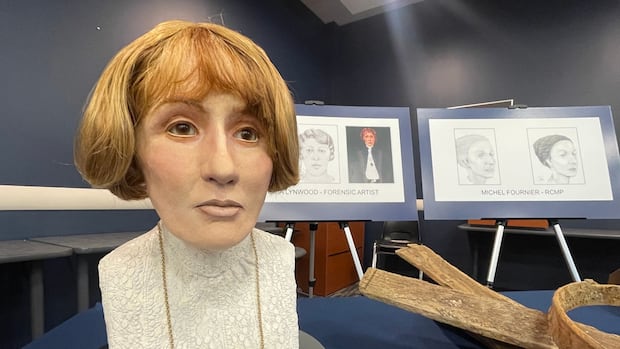SaskatchewanThe remains of an unknown female were discovered in a well shaft in Saskatoon’s Sutherland neighbourhood in 2006. Now she has been identified as Alice Spence (nee Burke), a woman of Irish ancestry, about 35 years old at the time of her death.Alice Spence (nee Burke) is believed to have been killed sometime from 1916 to 1918Lisa Risom · CBC News · Posted: Sep 29, 2025 6:18 PM EDT | Last Updated: 6 hours agoSaskatoon police have identified the remains of a woman found in a well in 2006 as Alice Spence (nee Burke), who died of foul play sometime from 1916 to 1918. This bust was made as part of the effort to identify the remains. (Kendall Latimer/CBC)Saskatoon police say they have solved a mystery that goes back more than a century.The remains of an unknown female were discovered in a well shaft in Saskatoon’s Sutherland neighbourhood in 2006. Now, almost 20 years later, she has been identified as Alice Spence (nee Burke), a woman of Irish ancestry who was about 35 years old at the time of her death.Investigators believe Alice, who lived in what was the town of Sutherland at the time, died of foul play sometime from 1916 to 1918.Cindy Camp, Alice’s great-granddaughter who lives in Sherwood Park, Alta., spoke with media at a news conference Monday about what it was like to be informed of Alice’s fate.”The whole thing was a total shock. We didn’t know anything about Alice’s circumstances,” Camp said. “On July 16 we got a phone call from the Toronto police asking us if we could give a DNA sample.”Camp said her grandmother, Idella, was orphaned at the age of 17 and never spoke about her mother. Idella died in 1995.”Knowing what we know now, I wish I could talk with my grandmother, even for an hour, to hear her side of the story. And while this has been an emotional journey, we are so grateful to the many individuals who have worked tirelessly over the years to give the ‘woman in the well’ her name back,” Camp said.From left, Bailey Solamillo, Lisa Solamillo, Sarah Corbiere and Cindy Camp — three generations of the Camp family — pose with police sketches of the ‘woman in the well,’ who has now been identified as Alice Spence. (Lisa Risom/CBC)The case sat for nearly 20 years without a lead until genetic science offered another avenue.Saskatoon police worked with members of Toronto police’s investigative genetic genealogy team to track down possible relatives and develop a family tree. Othram, a forensic genetic genealogy company, found five genetic relatives living in Alberta, the U.S., and Ireland.Alice lived a few blocks from the well. She moved to Sutherland in 1913 from St. Louis, Minnesota, with her husband Charles and young daughter Idella.Police say injuries on the body show Alice was assaulted prior to the murder.”We know she was murdered and put in the barrel, but we don’t know by whom,” Camp said.Alice’s remains were found by workers excavating underground fuel tanks at a gas station site at Central Avenue and 108th Street in 2006. The site was once occupied by the Shore Hotel.The body had been placed in a burlap sack, stuffed in a barrel and dumped about two metres down in a water well that was once used by the hotel.Forensic anthropologist Ernie Walker was called to the scene. He said the body was “well-preserved” due to the mixture of water and gasoline in the ground. He gathered DNA from two teeth and hair.”My colleagues and I used heavy equipment, did some excavation around the well and took it apart board by board,” Walker said. “Unknown to the individual that dropped it, a piece of cribbing of the well had broken loose and blocked the barrel from going all the way down to the bottom.”Pieces of the barrel that Alice Spence’s remains were found in. (Lisa Risom/CBC)Saskatoon police say they have a suspect in the murder, but are not releasing any information, as the suspect would be long dead by now. They consider the case closed and will not pursue any other justice.Alice’s remains were buried in Woodlawn Cemetery in 2009. Camp and her family plan to put a headstone with Alice’s name and date of birth on the grave.”Now that we know that we are genetic matches, it’s important for her to have her place,” Camp said. Three generations of the Camp family attended the police news conference.Police released some biographical information about Alice as part of the announcement. Alice was born in September 1881, one of five children, in Michigan, U.S. In 1902, she moved to Duluth, Minn., with her mother and two brothers, and worked as a seamstress and clerk.A marriage certificate shows she married Charles Irvine Spence in St. Louis, Minn., in 1904 and gave birth to their daughter Idella in 1905.In February 1916, Alice gave birth to a daughter who died the same day. The 1916 census shows Alice, Charles and Idella living in Saskatoon. A newspaper article from 1918 details the Spence house being destroyed by fire while the family was away. The 1921 census lists Charles as living with his daughter Idella, and a housekeeper and her son. Charles died of a heart attack May 16, 1923, leaving Idella orphaned.Police say this is believed to be the oldest investigation in Canada to be solved with the assistance of investigative genetic genealogy.ABOUT THE AUTHORLisa Risom is a journalist with CBC Saskatchewan.
Saskatoon police identify century-old remains of ‘woman in the well’ found in 2006











